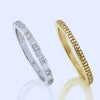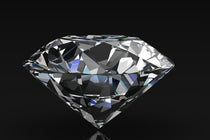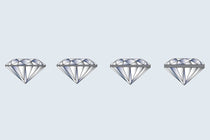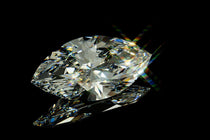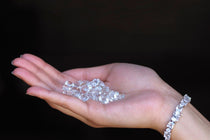Moissanite and white sapphire are two popular alternatives to diamonds for engagement rings and other jewelry. Both stones have their own unique characteristics, making them appealing choices for those seeking a high-quality gemstone without the hefty price tag of diamonds.
Moissanite is known for its exceptional brilliance and fire, making it visually stunning under various lighting conditions. This gemstone is composed of silicon carbide and is quite durable, ranking 9.25-9.5 on the Mohs scale of hardness. It closely resembles a diamond, but The Difference: Moissanite vs Lab Grown Diamond highlights that discerning between the two can be difficult even for experts.
On the other hand, white sapphire is a colorless variety of the corundum mineral family, which includes ruby and sapphire. It ranks 9 on the Mohs scale, making it a durable option for everyday wear. While white sapphires don't have the same level of brilliance as moissanite or diamonds, they remain a popular choice due to their affordability, beauty, and natural origins. Choosing between moissanite and white sapphire ultimately depends on individual preferences and priorities.
Defining the Gems
Moissanite and white sapphire are both popular choices for individuals seeking an alternative to diamonds. Each gemstone offers unique characteristics that make them stand out.
| Characteristic | White Sapphire | Moissanite |
|---|---|---|
| Hardness | 9/10 | 9.25/10 |
| Color | White or colorless; no impurities | White or colorless; may have impurities |
| Price | Starts at $500 per carat, goes up to $10,000+ | Ranges from $600 to $5,000+ |
| Symbolism | Brings peace, honors higher mind, prosperity | Associated with luck, love, and goal achievement |
| Origin | Found in various parts of the world (Australia, Thailand, etc.) | Originally found in a meteor in Arizona, now lab-created |
| Treatments | Often treated for color and inclusion | Usually left untreated for brilliance and fire |
Moissanite
It is a gemstone made from silicon carbide. Discovered in 1893 by Henri Moissan, it has since become a popular diamond substitute due to its durability, brilliance, and lower cost. Moissanite exhibits a higher refractive index than diamond, resulting in increased fire and brilliance, sometimes even surpassing a diamond's optical properties. However, it is worth noting that moissanite has a slightly lower hardness rating than diamond, albeit still quite durable.
Pear Cut Blue Moissanite Ring, Marquise Cut Muse Engagement Ring
White sapphire
On the other hand, is a variety of corundum. Corundum is a mineral that forms sapphires and rubies, depending on the presence of trace elements like iron, titanium, chromium, or vanadium. White sapphire is essentially a pure, colorless corundum. It has a lower refractive index and less brilliance compared to moissanite and diamond, but it is still a durable and beautiful option for jewelry. Additionally, sapphires are celebrated for their healing energy among alternative healers and crystal enthusiasts.
In summary, moissanite is a silicon carbide gemstone known for its dazzling brilliance and fire, making it a popular diamond alternative. White sapphire is a colorless corundum gemstone with a subtle elegance and a reputation for healing energy. Both moissanite and white sapphire offer unique properties that set them apart from traditional diamonds, making them fitting choices for those seeking distinct and captivating gemstones.
Appearance & Brilliance
Moissanite and white sapphire are both popular choices for those looking for a stunning white gemstone for their jewelry. Each stone has its unique qualities that make it stand out from the others.
When discussing sparkle, moissanite is known for its exceptional brilliance. This gemstone has a higher refractive index than white sapphire, which results in a more intense and fiery sparkle. In contrast, white sapphire has a more subtle and subdued sparkle, making it a suitable choice for those who prefer a more understated appearance.
In terms of color, moissanite is generally found in a colorless or near-colorless form, closely resembling the appearance of a diamond. On the other hand, white sapphires can range from completely colorless to having a slightly yellow or gray hue. This variation in color can impact the overall brilliance and value of the stone.
When considering hardness, moissanite scores a 9.25 on the Mohs scale, making it an incredibly durable and scratch-resistant gemstone. White sapphires also have a high hardness, with a score of 9 on the Mohs scale. Although both stones are highly resistant to scratches and wear, moissanite's higher score means that it can withstand slightly more wear and tear than white sapphires over time.
The price of these gemstones can also be a significant factor in the decision-making process. Moissanite is known to be an affordable alternative to diamonds, and it often costs less than white sapphires. However, the exact value of each stone will depend on factors such as size, color, and quality.
In conclusion, both moissanite and white sapphire offer different qualities in terms of appearance, brilliance, and durability. The choice between these two beautiful gemstones ultimately comes down to personal preference and the desired look for the jewelry piece.

Structural Composition and Hardness
Moissanite and white sapphire are both popular choices for jewelry, but they have distinct differences in their structural composition and hardness. Moissanite, a lab-created gemstone, is made from silicon carbide and has a refractive index of 2.65-2.69, which gives it exceptional brilliance and fire. On the other hand, white sapphire is a natural mineral corundum, sharing the same chemical composition as rubies and blue sapphires (aluminum oxide) but without the presence of trace elements that would give it color.
In terms of hardness, moissanite scores a 9.25 on the Mohs scale, making it one of the hardest gemstones after diamond. This attribute contributes to its durability and resistance to scratching or chipping, making it suitable for everyday wear. To care for moissanite jewelry, simply follow the instructions found in this guide on how to care for moissanite jewelry.
White sapphire, with a 9 on the Mohs scale, is slightly less hard than moissanite but still durable for daily wear. This gemstone exhibits a vitreous luster, which means it has a glass-like sheen but doesn't display the same level of fire and sparkle as moissanite. While both moissanite and white sapphire are strong candidates for engagement rings, there are other factors to consider, like durability and price, when choosing between moissanite rings vs. diamond rings.
In summary, the structural composition and hardness of moissanite and white sapphire differ significantly, with moissanite being the lab-created option with impressive brilliance and a higher hardness level. On the other hand, white sapphire, a natural gemstone, offers a more subtle sparkle and slightly lower hardness. Both gems have their own unique appeal, and ultimately, the choice between them comes down to personal preference and other considerations, like price and durability.
Cutting and Durability
| Characteristic | Moissanite | White Sapphire |
|---|---|---|
| Cutting Quality | Excellent | Excellent |
| Durability | Very durable | Highly durable |
When comparing moissanite and white sapphire, it's crucial to consider their cutting and durability. Both gemstones are popular choices for jewelry, but they exhibit different characteristics in terms of cut quality and durability.
- Moissanite is known for its excellent light performance, which has led to higher demand in using it as a diamond substitute. This gemstone is cut to maximize its brilliance, fire, and scintillation, making it visually stunning. In addition to its stunning appearance, moissanite is an incredibly durable gemstone, ranking 9.25 on the Mohs scale of hardness. This high score means that moissanite is resistant to scratches and chipping, making it ideal for daily wear.
- White sapphire, on the other hand, is often cut to emphasize its transparency and purity. While it may not have the same brilliance and fire as moissanite, it still possesses a classic beauty of its own. In terms of durability, white sapphire scores 9 on the Mohs scale, making it slightly less durable than moissanite. However, it is still a hard and durable gemstone that can withstand everyday wear and tear.
- Both gemstones can be cut into various shapes and styles, but the cutting technique may differ due to the optical properties of each stone. For example, moissanite displays optical features that can affect the overall appearance and sparkle of the finished product, so cutters must take these factors into account when working with this material.
- While both moissanite and white sapphire are durable gemstones, they are not completely immune to flaws. Careful inspection can reveal inclusions or other imperfections that may lower the value of a stone. Therefore, it is essential to closely examine any moissanite or white sapphire you are considering for purchase to ensure their quality and authenticity.
In conclusion, both moissanite and white sapphire offer unique qualities in terms of cutting and durability. Moissanite is known for its exceptional brilliance, fire, and scintillation, along with its impressive durability. White sapphire, though not as brilliant, provides a classic look and is still a durable option for jewelry. When comparing these two gemstones, it is essential to understand their unique characteristics and make an informed decision based on your preferences and needs.
Cost and Affordability
| Characteristic | Moissanite | White Sapphire |
|---|---|---|
| Price Range | Ranges from $600 to $5,000+ | Starts at $500 per carat |
| Affordability | Varies; moderate to higher cost | Generally more affordable |
When comparing moissanite and white sapphire, one important aspect to consider is their price and affordability. Moissanite, being a lab-grown gemstone, is generally more budget-friendly than white sapphire. The price tag of moissanite depends on factors such as size, quality, and brand reputation, but overall, moissanite is considered a more affordable option.
White sapphires are natural gemstones and can sometimes be more expensive than moissanite, but the prices can vary based on their origin, color, clarity, and overall quality. However, when compared to diamonds, both moissanite and white sapphire are significantly more affordable options, allowing those with varying price points to find a gemstone that fits their budget.
Factors such as the setting, the ring design, and added embellishments can also affect the overall cost of the engagement ring or jewelry piece. While moissanite tends to have better clarity, cut, and refraction properties compared to white sapphire, the choice ultimately depends on personal preference and priorities.
In conclusion, both moissanite and white sapphire offer cost-effective alternatives to diamonds without compromising their visual appeal. The affordability of these gemstones allows individuals to choose a beautiful and meaningful piece of jewelry within their budget, making both moissanite and white sapphire popular options.
Ethics and Sustainability
| Characteristic | Moissanite | White Sapphire |
|---|---|---|
| Ethical Sourcing | Largely lab-created; fewer ethical concerns | May involve mining; ethical sourcing varies |
| Sustainability | More eco-friendly due to lab synthesis | Dependent on mining practices; varies |
When it comes to choosing between moissanite and white sapphire for jewelry, factors such as ethical sourcing and ecological impact play a significant role. Moissanite is a lab-grown gemstone, making it a more sustainable and eco-friendly option compared to mined gemstones like white sapphire.
Lab-grown moissanites have a lower ecological footprint than mined white sapphires, as their production does not require mining and the associated land disturbance. This sustainable process also reduces the risk of habitat destruction, water pollution, and greenhouse gas emissions.
Moreover, moissanite production involves ethical practices as the gemstones are created in controlled environments without the need for exploitative labor practices, typically associated with mining operations. Ethical concerns are especially crucial for conscious consumers seeking environmentally friendly and socially responsible jewelry options.
Moissanite also offers brilliance and durability comparable to diamonds, making it an attractive alternative for those looking for an ethically sourced gemstone that lasts a long time. On the other hand, white sapphire is relatively less durable and may require more maintenance over time, which may impact its sustainability in the long run.
In conclusion, choosing moissanite over white sapphire for jewelry purposes can offer not only a visually stunning gemstone but also a more ethical and sustainable option that aligns with the values of modern, eco-conscious consumers.
The Diamond Alternative Debate
When looking for a diamond alternative, two popular options that often spark debate are moissanites and white sapphires. Both are diamond simulants, offering their own unique sets of pros and cons that can influence a person's decision on which gemstone to choose for their jewelry.
Moissanites, first discovered in a meteor crater, are lab-grown gemstones that closely resemble diamonds. They showcase exceptional brilliance and fire, often surpassing the sparkle of a natural diamond. In terms of durability, moissanites rank at a 9.25 on the Mohs scale of hardness, making them a long-lasting choice for engagement rings. One of the primary advantages of moissanites is their affordability, as they are more cost-effective than diamonds, without compromising on beauty and quality.
White sapphires present another appealing diamond alternative. Though not as brilliant as moissanites or diamonds, these gemstones possess a unique charm with their subtle sparkle. Ranking at a 9 on the Mohs scale, white sapphires are durable and provide a timeless aesthetic. Moreover, they are considerably more affordable than diamonds and can be sourced ethically, ensuring that your jewelry has minimal impact on the environment.
The choice between moissanites and white sapphires can boil down to individual preferences and priorities. When it comes to brilliance and fire, moissanites have the edge over white sapphires. However, some people may be drawn to the understated elegance and natural origin of white sapphires. Budget considerations can also play a significant role in this decision, as both gemstones are more affordable than natural or lab-grown diamonds.
In conclusion, moissanites and white sapphires each have their distinct characteristics that set them apart as diamond alternatives. It's essential to weigh the pros and cons of each gemstone carefully and align them with your personal preferences, priorities, and budget to make the best choice for your jewelry needs.
Frequently Asked Questions
How do moissanite and white sapphire compare in terms of hardness?
Moissanite is known for its high hardness, ranking at 9.25 on the Mohs scale. This makes it a durable and resistant stone suitable for everyday wear. On the other hand, white sapphire has a slightly lower hardness of 9 on the Mohs scale, still considered durable but slightly less so than moissanite.
Which stone is more affordable: moissanite or white sapphire?
In most cases, white sapphire tends to be more affordable than moissanite. While both stones are less expensive than diamonds, the price of moissanite can be closer to that of a diamond due to its similar visual qualities and durability. However, the exact pricing may vary depending on the size, cut, and quality of the specific gemstone.
Which gemstone appears more like a diamond: moissanite or white sapphire?
Moissanite is generally considered to appear more like a diamond than white sapphire. It has a higher refractive index than both sapphire and diamond, which gives it impressive brilliance and fire. White sapphires, in contrast, have a lower refractive index and often display less fire, making them appear a bit more subdued than diamonds or moissanites.
What are the differences in durability between moissanite and white sapphire?
As discussed in the hardness section, moissanite has a slight edge in terms of durability due to its higher ranking on the Mohs scale. This means it is less susceptible to scratches and chipping, making it a more suitable option for daily wear in engagement rings or other jewelry that may encounter potential impacts.
How do the brilliance and fire of moissanite compare to those of white sapphire?
Moissanite tends to display more brilliance and fire than white sapphire. Its higher refractive index causes it to bend light more effectively, resulting in the intense sparkle and rainbow-like colors that it is known for. In comparison, white sapphires are more subdued with their light performance, appearing less radiant in comparison to moissanites and diamonds.
What are the pros and cons of choosing moissanite or white sapphire for engagement rings?
Moissanite's primary benefits are its impressive brilliance, fire, and durability, making it an ideal choice for those seeking a diamond alternative that maintains similar visual qualities. However, it can still come at a higher cost than white sapphire.
On the other hand, white sapphire offers a beautiful and more affordable option for those on a budget. It also provides added durability and wear resistance compared to many other gemstones used in jewelry. However, it does not hold the same level of brilliance and fire as moissanite or diamonds. Ultimately, the choice between moissanite and white sapphire will depend on personal preferences, budget, and the desired appearance of the engagement ring. Learn more about moissanite engagement rings here.
Checkout some of our top collections:




